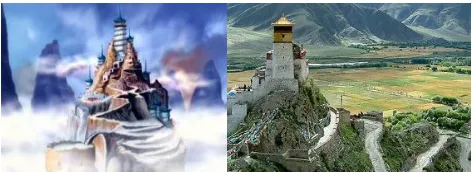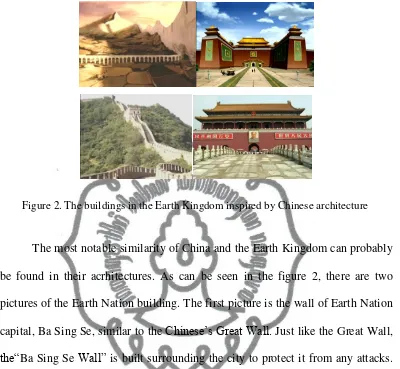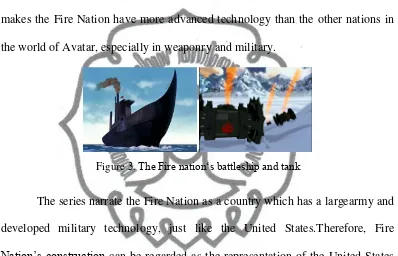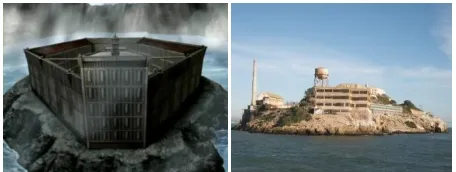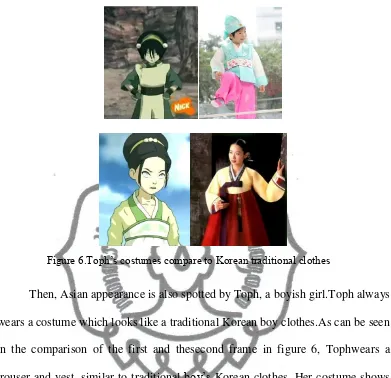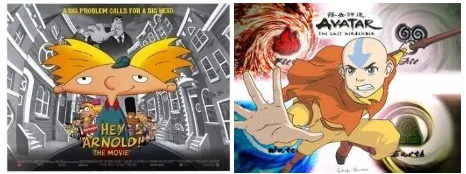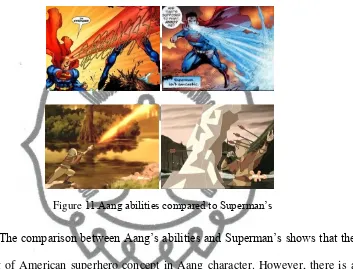commit to user
PRESERVING AMERICAN DOMINANCE THROUGH
GLOBAL CULTURE CONSTRUCTION IN
AVATAR: THE LAST AIRBENDER
THESIS
Submitted as a Partial Fulfillment of Requirement
for the SarjanaSastra Degree of the English Department
Faculty of Letters and Fine Arts
SebelasMaret University
by:
ARWAN WISNU PRADANA
C0306001
ENGLISH DEPARTMENT
FACULTY OF LETTERS AND FINE ARTS
SEBELAS MARET UNIVERSITY
SURAKARTA
commit to user
commit to user
commit to user
iv
PRONOUNCEMENT
Name : ArwanWisnuPradana
NIM : C0306001
Hereby, it is stated that this thesis entitled “Preserving American Dominance
through Global Culture Construction in Avatar: The Last Airbender” is made and completed by the researcher. It is not plagiarism nor made by others.
Everything related to other people’s works are written in quotation and mentioned
within the bibliography. If it is then proved that this pronouncement is incorrect,
the researcher will be ready to take the responsibility.
Surakarta, 13 September 2012
The researcher
commit to user
v
MOTTO
“
Ora et labora
”
“
Where there's a will, there's a way
”
“
Today is always the most enjoyable day
”
commit to user
vi
DEDICATION
The thesis is dedicated to:
Myself,
My beloved family,
commit to user
vii
ACKNOWLEDGEMENT
First of all, I want to thank Allah SWT, for the blessing so that I can finish
this thesis. Thank you for giving me strength and showing me the right direction
in making a decision. So many support and helps are given to me so that this
thesis can be finished well. Therefore, I would like to say my deepest gratitude for
themall in this acknowledgement.
I want to thank Drs. RiyadiSantosa, M.Ed., Ph.D, the Dean of Faculty of
Letters and Fine Arts, and Drs. AgusHariWibowo, M.A., Ph.D, the Head of
English Department, for giving me permission to write the thesis. I want to
thank all English Department’s lectures, especially the American Studies’
lecturers, for giving me a lot of knowledge and understanding of American
Studies.
I give my deepest gratitude to FitriaAkhmertiPrimasita, S.S., M.A, as my
thesis advisor who gives her full support and time helping me in writing this
thesis. Thank you for being a patient advisor. Thank you for all knowledge and
advices have been given.
I thank the board of examiners: Dra. S.K. Habsari, M.Hum, Ph.D., Taufiq
Al Makmun, S.S., M.Si., and KaruniaPurna K, S.S., M.Si.for sharing their
precious criticism that contribute to this thesis.
Thanks for my beloved family. My Mom and Dad, my “Mr. and Mrs
commit to user
viii
thank my little sister, you can always cheer me up with your absurd and silly acts.
After all, I am meaningless without them.
I specially thank Chindy and Wulan. This thesis is finished for you, Lan.
For Chindy, it has been finished then it is time to finish the other things. Both of
you are extraordinary for me. Thanks for the support, care, time and everything
have been given to me.
I gratefully thank all of my friends in English Department 06. It was an
amazing years with all of you guys. I want thank Kiki for the sharing knowledge,
the discussion, and your sharp-tongue.It will need agreat effort to finish this
thesiswithout your help. To Iyum, let get your thesisfinished. For Lala and Bimo,
Vadila and Vendra, be a happy couple. To Vika, Dila, Hamid, Susi, Pondra, Rena,
Herman,Fajar, and all my friends in ED 06 who I can not mention one by one,
thank for the friendship. It is wonderful to know you all.
I also want to say thank you to my friends in Cattleyaboarding house. For
Hanif, Singgih, Fiqi, Naja, Fikri, and Arnaz, it is nice to be part of you all.
Last but not least, I want to say thanks to everyone who has given
contribution inthe writing of the thesis whose name can not be mentioned here one
by one. Thank you very much.
Surakarta, 13 September 2012
commit to user
ix
TABLE OF CONTENTS
TITLE ... i
APPROVAL OF THE ADVISOR ... ii
APPROVAL OF THE BOARD OF EXAMINERS ... iii
PRONOUNCEMENT ... iv A. Globalization and Global Culture ... 16
B. Asian culture…………...………... 20
C. Animation... 24
D. Semiotic Theory ... 31
CHAPTER III: DISCUSSION A. The Construction of Global Culture in Avatar: the Last Airbender ... 35
1. The Construction of Global Culture in the Setting of Place of
Avatar: the Last Airbender...
commit to user
x
2. The Construction of Global Culture in the Main Characters of
Avatar: the Last Airbender ... 42
3. The Construction of Global Culture in the Narration of Avatar: the
Last Airbender ... 61
B. The Domination of American culture in the Global Culture
Construction in Avatar: the Last Airbender…..………... 65
CHAPTER IV: CONCLUSION AND RECOMMENDATION
A. Conclusion ... 77
B. Recommendation ... 80
commit to user
xi
ABSTRACT
ArwanWisnuPradana. C0306001. 2012. Preserving American Dominance through Global Culture Construction in Avatar: The Last Airbender. Undergraduate Thesis.English Department of Faculty of Letters and Fine Arts SebelasMaret University.
This research is purposed to explain how the global culture is constructed in the animation series and how the global culture construction preserves Americandominance, whether the creators respond to the changing course of global culture in construction of Avatar: the Last Airbenderortheypreserve the American culture in the construction of the global culture.
This research is a descriptive qualitative research which uses several episodes of Avatar: the Last Airbenderanimation seriesas its source of data. The primary data consists of dialogues, characters and characterization, and setting of place. It is supported with secondary data taken from of journals, internet articles and another animation series.
The research is conducted under the framework of American Studieswhich is an interdisciplinary study. Therefore, it involves some disciplines in the forms of theory and approach in analysing the animation series.In answering the research question, the researcher uses global culture theory, semiotic theory, and socio-cultural approach.
After conducting the research, it is found that Avatar: the Last Airbenderis constructed with global culture value that combines American and Asian culture. The construction of the main characters, setting of place, and the story showtheglobal cultureasa combination of American andAsian culture influence. However,the animation series still preservesAmerican culture dominancedespite its rich Asian culture influence.It can be said as American value in Asian package. This is an Americans’ response ofthe emergence of Asian rising power thatmakes a changing course of global culture.They try to find a way to welcome Asia as the new global culture and at the same time preserve their domination in the world's cultural contestation.
Keywords: global culture, popular culture, Asian culture, American dominance,
commit to user
1
CHAPTER I
INTRODUCTION
A. Research Background
Globalization has changed the world condition today. It influences many
aspects of life and relations of society in the world. Globalization has given a
strong impact to every part of human life. It changes the way people
communicate, changes cultures and even it can change the taste of food.
Globalization hasled to aprocess in making global culture of the world.
Globalization isnot only seen as a process but also a project, not only a realitybut
also belief. It is believed that global culture will emerge with the rise of
globalization (Wang and Yeh, 2005, p.176). Everything, especially products of
culture, nowadays seem to have the same taste. This phenomenon can be called as
global culture.
Global culture refers to the way globalization has undermined national and local cultures, with cultural products and ways of life in different countries of the world becoming more alike. It is a synergetic effect of market forces, technology, and freedoms of movement, a contemporary variant on the well-known theme of cultural diffusion, which for centuries has been a subject of study (Krzysztofek,2002, p. 4).
The society of the world has been entering the global economy where
people can have economic transaction andexchange technology and information
easily and globally. It also createswide marketplace for marketing any cultural and
consumer product.Global culture is often believed as American popular culture
commit to user
across the world and people seem to have one world culture.It is believed that the
world citizen will lose their cultural diversity and one culture will be experienced
by all people.
Global culture is believed as American culture (Barber, 1998, p. 1),
especially American popular culture. There are many American popular culture
products, for example music, fashion, fast food, and movie. Companies like
McDonald‟s, Coca Cola, Starbucks, and Nike are now symbols that are
recognized across the world, along with the consumer lifestyles and culture
associated with them.Another American popular cultures that widely spread all
over the world are American media empires with the movies and TV series.They
sell their television programs and program formats like Who Wants to be a
Millionaire?andAmerica’s Got Talent globally.
However these American popular culture products have no longer
dominated the world market.Another power emergesand erodes the American
domination. It is the rising of Asian power.China, Japan, India and South Korea
have arisen as the new economic power of the world.Now, their economic power
can be equalized with the United States‟ (Campbell, 2002, p. 61).This rising Asian
power has successfully penetrates global market with its commodities, especially
United States‟ market itself.The Asian cultures also spread along with these Asian
exported commodities. The Asian cultures, such as Asian food, fashion, or anime,
successfully take the people‟s interest. The rising Asian cultureseizes the
American culture position as the global culture (Tay, n.d.). Certainly, it changes
commit to user
The changing course of the global culture also changes the course of
American popular culture.This phenomenon brings a new development in
American popular culture, especially in the media industry. The American media
empires have noticed this phenomenon and tried to respond it. They try to
compromise with the changing course of global culture by modifying their
globalized products in order to preserve their existence and domination. One of
the compromises is employing and combining the rising culture, which is Asian
culture, into their product.As a globalized product, it requires adaptation to local
parameters of tastes and styles and may involve a level of coproduction between
corporations to share risk and attempt to maximize profit (Pagliassotti, 2009, p. 1).
The result ofthe changing course of American popular culture can be
seen in Avatar: the Last Airbender animation series. It can be regarded as one of
American TV series produced as a response to the emergence of global
culture.This animation is createddifferently from the other American famous
cartoon series and movies such as Disney‟s Micky Mouse, Warner Bros‟ Looney
Tunes, Scooby Doo or the other American cartoons. This animation series is
created with the combination of American and Asian culture influence.
The Asian cultures can be seen clearly in Avatar: the Last Airbender,
even it can be said that Asian culture plays a dominant role in the series(London
&Hamesley, n.d.). The character designs are heavily influenced by anime
(Japanese animation). This cannot be found inAmerican‟s animation movies and
series that have been mentioned before. There is another interesting aspect of
commit to user
series with Asian setting and culture influences. This animation series was also
produced by many crews coming from different background of culture
(www.avatarspirit.net). There are American, Chinese, Korean, Latin, and
Japanese. The production staff also employs an Asian cultural consultant.
Avatar: the Last Airbendertells a story about a 12-year-old boy named
Aang who was chosen to be an avatar, the world savior. Aang had to save the
world by defeating Fire Lord and his Fire Nation who wanted to dominate the
world. In the journey to save the world Aang met some friends who helped him in
his struggle to save the world, they were Katara, Soka, Toph, and Zuko. All of his
friends came from different background and culture, for instance Katara and Soka
were from Water Tribe, Toph came from EarthKingdom and Zuko came from Fire
Nation. Meanwhile Aang was an air nomad, he is the last and the only air nomad
in the world. In order to save the world, Aang must master the four elements
bending: air, water, earth, and fire bending. This story was ended with a happy
ending, Aang could master the four elements and finally he could defeat the Fire
Lord to save the world.
Avatar: the Last Airbenderis broadcastedfrom 2005 to 2008 by
Nickelodeon, an American cable television channel that specifically broadcasts
programs for children and tenageer. Avatar was set in Asian influenced
world.This animation series was co-created and produced by Michael Dante
DiMartino and Brian Konietzko. Michael Dante DiMartino is the executive
producer, co-creator, and story editor of Avatar series. He is an American
commit to user
n.d.). Brian Konietzko is an American executive producer and co-creator and for
Avatar: the Last Airbender, Brian is a storyboard artist and art director for the
Nickelodeon (ibid). This shows that both of Avatar: the Last Airbendercreators
are Americans. However, they could create a unique cartoon series with Asian
culture influence whichcan be regarded as a successful and popular animation
series (Tony, n.d.)
Avatar: the Last Airbenderis a successful animation series both in US
and outside US.Avatar is popular with both audiences and critics, gathering 5.6
million viewers on its best-rated showing and receiving high ratings in the
Nicktoons program lineup. This series has won many awards such as Pulcinella
Awards 2005 for the Best Action/Adventure TV Series and the Best TV Series,
Nickelodeon Kid's Choice Awards 2008: Favorite Cartoon, 2008 Peabody
Awards: "Unusually complex characters and healthy respect for theconsequences
of warfare", and many more (www.avatarspiritmedia.net).
Theuniqueness and successfulness of Avatar: the Last Airbendermake
this animation series interesting to be analyzed. Moreover, cartoon or animation
can reflect the anxiety within American culture.A study of animation also offers
insight into mytho-political, and indeed mytho-poetic zeitgeist of a nation (Wells,
1998, p. 6). For that reason, this research choseAvatar: the Last Airbenderas the
object of study. This research tried to find out how American, through Avatar: the
Last Airbenderanimation series, respond to the emergence of global culture. Do
the creators preserve the construction of global culture with the American culture
commit to user
Thus, it needs to find outhow global culture is constructed in Avatar: the Last
Airbender. The answer of this question leads to the next problem. It is about the
way global culture construction in Avatar: the Last AirbenderpreservesAmerica
dominance, as it is believed that American always maintain their dominance
especially in cultural contestation.
B. Scope of Study
This research focuses on the global culture that emerges recently and how
theAvatar: the Last Airbenderanimation series respondsto the emergence of global
culture. This research tries to analyze theconstruction of global culture in the main
characters, setting, and narration of Avatar: the Last Airbender. This research only
focuses onthe discussion of the three elements of the animation series.It does not
bring the discussion into further analysis of animation because this
researchonlyanalyzes the global culture that emerges in elements ofAvatar: the
Last Airbenderanimation series.
C. Research Questions
Based on the background above, this research formulates research
questions as follows:
1. How isglobal cultureconstructedin Avatar: the Last
Airbenderanimation series?
2. How does the global cultureconstruction in Avatar: the Last
commit to user
D. Objectives of the Study
Based on the research questions, the objectives of the thesis are:
1. To explain how global cultureis constructedin Avatar: the Last
Airbenderanimation series.
2. To explain how the global culture construction in Avatar: the Last
Airbenderpreserves American dominance.
E. Benefits of the Study
This research is conducted in the substances of:
1. Providing data and analysis about global culture especially that
emerges in Avatar: the Last Airbenderanimation series.
2. Giving knowledge about the American popular culture especially in
the scope of cartoon and animation series.
F. Research Methodology
1. Type of Research
The method of research employed in the study is descriptive qualitative.
Descriptive qualitative research is a research that collects descriptive data and the
written results of the research contain quotations from the data to illustrate and
give description of the report (Bogdan&Biklen, 1982, p. 27). The collected data
commit to user 2. Data and Source of Data
This research uses two kinds of data. They areprimary data and supporting
data. The primary data refer to the firsthand observation and study by a researcher
(Berger, 2000, p. 23). The primary data consistsof dialogues, characters and
characterization, and setting of placecollected from the source of data.The source
of data of this research isall of the episodes of the animation series entitled Avatar:
the Last Airbender produced by Michael Dante DiMartino and Brian Konietzko.It
comprises all of the season of the series which totally consists of 61 episodes.
The supporting data arein the form of information related to the topic of
the research. The supporting data includes information of the socio-cultural
condition of American society, information related to Avatar: The Last
Airbenderanimation series,other animation series, journals,and internet articles
whichare obtained by browsing the internet and doing library studies.
3. Technique of Collecting Data
The research is started by watching the serial Avatar: the Last
Airbenderrepeatedly in order to understand the story well and collect the data. The
data are collected by watching the series repeatedly and cutting the scenes from
Avatar animation series. The scenes are cut into several still pictures to make the
analysis easier. Then, the scenes are selected to collect the scenes that contain the
commit to user
which areappropriated with the research objectives and contained important
information related to the research.
4. Technique of Analyzing Data
The main data are first selected and classified in order to make this
research stay focus on the research questions. After having classified, the data are
analyzed by using some theories. Interdisciplinary approaches are used in
conducting the analysis. The supporting data are also used in the analysis to give a
further information and understanding about the main data.The last step is making
the conclusion to complete the research.
G. Theoretical Approach
Thisresearchis conducted under the framework of American
Studies.American studies isthe study of American culture and it is a branch of
modern literate culture studies that requires knowledge of many discipline (Sykes,
1963, p.255). American Studies is an interdisciplinary study, it allows to enclose
multidisciplinary approaches in analyzing data. It means that several approaches
can be applied to analyze the data. It needs to employ several kinds of approaches
in order to conduct the analysis and answer the problem statement, especially in
analyzing text into context. Neil Campbell and Alasdair Kean state that the center
of an interdisciplinary enterprise is the relationship between text to be studied and
context from which they come (Campbell and Kean, 1997,p. 4). The text which is
commit to user
the respond of the emergence of global culture in the series is the context that is
tried to be exposed in the analysis.
One of the American studies‟ focus is on popular culture. Popular culture
can be defined as mass commercial culture that is produced in mass by profit
conscious creators (“Pop Culture”, n.d.). Nachbar and Lause state that popular
culture is a product of culture that has been accepted or approved of by large
numbers of people. Popular culture comes from the society and it reflects the
condition of the society in the form of beliefs and values (Nachbar and Lause,
1992, p. 12). Animation series or cartoon are popular culture products, they are
created by producer in order to gain profit and also enjoyed by large number of
people.
Avatar: the Last Airbender, the source of data in this research, is an
animation series and it is considered a product of American popular culture.
Therefore, popular culture theory can be used to analyze Avatar: the Last
Airbenderto reveal the context existingin it. From this background, hence studying
American‟s response to the emergence of global culture can be conducted through
studying animation series as American popular culture.
Since the object of study is animation, it needs to employ animation
theory to know the basic understanding of animation. The animation theory
studies the creation of animation. It studies how the creation of movement in
paper, manipulating clay, adjusting model and putting into the frames of film
(Wells, 1998, p. 10).However, animation is not just a giving motion to a drawing
commit to user
animation can carry important meaning and engage with social issues. This
research employs the theory developed by Paul Wells. He argued that studying
animation is about analyzing how meaning is generated by unique vocabulary
available to the animator which is not provided by live-action film-maker(ibid:
11). This is what makes animation different from movie.Movie presents the
construction of the narrative and visual environment by copying the real world, it
is tried to have a construction as similar as the real world.Meanwhile, animation
tends to transform the reality into the construction of its narrative and visual
environment (Holloway in Wells, 1998, p. 10).Therefore, analyzing animation is
different from analyzing movie.
Animation is created with the process of giving movement to an object
through process of drawing, manipulating and adjusting object, and many more.
However,animation is not only an art of movement drawing (Solomon in Wells,
1998, p. 10) but it also a drawing that represents human ideas (Bendazzi in Wells,
1998, p. 7). The creation process also involves the style and idea of the creator.
Therefore, it will produce a distinct feature that only possesses by animation. The
animation theory is used to identify the distinct feature of animation,so that it can
be conducted analysis through this distinct feature.
The research deals with animation series which isproduced through a
construction process. Therefore, it needs a semiotics supported with understanding
of animation theory in conducting the analysis.Semiotics is used as the main tool
to analyze the object of research and to explore how animation as a popular
commit to user
Semiotics has become the main instrument in cultural studies research.
Semiotics can be used for analyzing any product of human culture from pictures,
clothes, body language, including animation film and series. Semiotic is the
science of sign (Berger, 2000, p. 35). It is important to apply the semiotic because
the main data is an animation series that contains many signs.The theory of
prominent figure in semiotics, Roland Barthes, is applied in the analysis.Roland
Barthes‟ theory is based on semiology of Ferdinand de Saussure.Saussure divides
sign into signifiers and signified. The signifiers are the sounds and images, and
the signified are the concept brought by the sounds and images into our mind.
Both of them have an arbitrary relation (ibid:37).According to Barthez, there are
two level of signification; denotation stage andconnotation stage. The signifier
and signified are the first level of signification called as denotation.Behind the
first level of signification, there is secondary significationthat is called as
connotation.Barthezuses the concept of connotative semiotics to reveal the myth
behind a text (Noth, 1990, p. 312).
The animation scenes which are produced through construction process
will deliver denotative and connotative meaning. Therefore the animation scene
must not be interpreted as it is, since it contains connotative meaning. The
connotative meaning in series animation isconstructed in the elements such as
characters, setting, and narration.To understand the connotative behind the
construction, it needs the use of semiotics. However,discovering the connotative
meaning must consider the construction of the animation series element. It is
commit to user
construction of the character, it is found that an American animation character
constructed with Asian appearance and costume. Here, semiotics takes its role as a
tool to read the text.It is used to discover what is happened behind the employing
of Asian culture influence in American animation.
Besides the understanding of the signs in the animation and its
signification,it needs to understand social and cultural background of a society
where the animation series come from. Therefore, this
researchemployssosio-cultural approach.The socio-researchemployssosio-cultural approach is used to know how human social
and activity are organized through culturally constructed artifact (Lantolf, 2000:
1). The culturally constructed artifact here can be any product of human culture,
Moving picture, such as film and animation, can be categorized as artifact, or
product of culture, that is culturally constructed (ibid). In this research, the
socio-cultural approach is used to analyze the global culture phenomenon existing in the
animation series. It is used to know the influence of the social and cultural
condition toward the construction of global culture in Avatar: the Last Airbender,
especially in its relation to the globalization. The socio-cultural approach can be
applied in analyzing global culture since global cultureemerges from social
intercourse of different people and different cultures (Tomlison, n.d.)
Global culture as a part of globalization process is often believed as the
way of Americanization (Barber, 1998, p. 1). It is parallel with theory developed
by Benjamin R. Barber. It is believed to the ideathat lifestyles, cultures and
consumer behavior will be similar all around the world, which is
commit to user
world in the globalization. One of American‟s tools to achieve this is popular
culture. America adopted and „Americanized‟ local cultures and construct them
into their popular culture product containing American ideology. Then it is
exported to other parts of the world through free-market ideologies (Capcioglu,
2008, p. 11). This research argues that thisis what happens in the construction of
Avatar: the Last Airbender.Using global culture theory, this research tries to
analyze how America preserves the dominance through the construction of global
culture in Avatar: the Last Airbender.
H. Thesis Organization
This thesis is divided into four chapters and each chapter is divided into
some subchapters. Those chapters are Chapter I Introduction, Chapter II Literature
Review, Chapter III Discussion, and Chapter IV Conclusion and
Recommendation.
The first chapter, Introduction is divided into eight subchapters. These are
Research Background, Scope of Study, Research Questions, Objectives of the
Study, Benefits of the Study, Research Methodology, Theoretical Approach, and
Thesis Organization.
The second chapter, Literature Review, contains contextual and theoretical
review. It explains about globalization and global culture, Asian culture,
Animation which comprise American and Japanese animation, and Semiotic
commit to user
The third chapter, Discussion, contains the analysis of the research. It is
divided into two subchapters. The first subchapter discusses about the
construction of global culture in the main characters, setting and narration
ofAvatar: the Last Airbender animation series. The second subchapter describes
how the global culture representation in the series preserves America‟s attempt to
still dominate in the world cultural contestation.
The last chapter, Conclusion and Recommendation, provides explanation
commit to user
16
CHAPTER II
LITERATURE REVIEW
A. Globalization and Global Culture
The world is now experiencing a process called globalization, where
everything in the world becomes universal. Globalization refers to the process
which includes activities beyond a nation‟s border, and consolidation of group
within new time and space combination (Capcioglu, 2008, p.10). Globalization is
the result of the development in communication, transportation, and information
technologies. The growing of economy, politic, technology, and culture makesit
easier for the individuals, society, businesses, and governments around the world
to interact. It can be seen as a worldwide socio-cultural phenomenon that affects
every aspects of human culture in everyday life. It seems that the world has no
distanceanymore.
Globalization is mostly attributed to the improvement in
communications, information technologies, and transportations.The development
of communication device, such as cell phone and Internet, has made it much
easier for people togive and to accessinformation. The communications satellites
also allow global television channels to broadcasttheir programs and news all
around the world.Improvements in transportations are also part of globalization.
The advances of transportation vehicle make the world smaller because it only
needs a little time totravel to another place in the world.The advances of
commit to user
ship their products around the world.All of the improvements have influenced
social and cultural activity of the society all around the world.
For a long time, America has a bigcontribution in promoting
globalization.
US culture is now penetrating every continent through the dramatic growth of mass communications such as music, television, films and the Internet, as well as through the penetration of American corporations into foreign countries. From China to France to the Middle East, foreign leaders and activists have expressed fear that global culture may become too Americanized, destroying their own cultural, economic, and religious traditions.(Jaja, 2010, p. 117)
The worldwide spread and dominance of American culture becomes the most
controversial aspects of globalization. Many people fear that the spread of
American culture throughout the world will replace their cultural diversity and
globalization has been seen as Americanization.As stated by Wolfe, some
academics, journalists, and political activists see this as cultural uniformity and
consider it as an enemy (as cited in Heumann, n.d.). In fact, it can be seen that
many people in the world try to adopt and adjust toward American mores and
culture. Thus, this helps the spreading of American brands and commodity across
the world.
A debate about cultural globalization has emergedin social science.There
is always a debate between scholars whether globalization will bring uniformity
and homogenized culture or it will enrich the cultural differentiation by the
interaction between global and local culture. Featherstone states that research in
cultural globalization includes two rival hypotheses (as cited in Capcioglu, 2008,
commit to user
world. The most known theory is developed by Benjamin R. Barbercalled
“McWorld” theory.Barber argues that global culture is American.It is believed
that we live in “McWorld”, a world which is trapped within American culture.
McWorldrepresents anAmerican push into the future animated by onrushing economic, technological, and ecological forces that demand integration and uniformity and that mesmerize peopleeverywhere with fast music, fast computers, and fast food,MTV, Macintosh, and McDonald's -pressing nations into one homogeneous global culture, one McWorld tied together by communications, information, entertainment, and commerce.(Barber, 1998, p. 29).
Barber‟s theory emphasizes on how American culture exported to another place in
the world throughtheir popular culture product.US media and entertainment
industries, such as Disney and Hollywood, play a big role in exporting this
product of culture.
Nowadays, the popular culture industries believe on cultural integration of
the world. They also believe that cultures, lifestyle, and consumer behavior will
become similar all around the world.The process of globalization tends to
homogenize and make some parts of the modern social life universal. People have
accepted the globalization and they have experienced similar culture.
However, at the same time, they try to resist the globalization by
preserving and rebirthing their local and traditional culture. This leads to the
second theory that believes on complex interaction between global and local
culture. This theory emphasizes on how globalization process and local/national
culture become interrelated. Furthermore, thisinteraction can produce cultural
hybridization and cultural differentiation (Capcioglu, 2008, p. 12).Hybridization
commit to user
culture interacts with the global culture. Even, sometimes a mixture of culture
creates a new culture that can not be classified into a certain culture.
This research believed on the theory arguing that globalization has
produced one world culture or called as global culture.This is an impact of three
globalization basic dimensions which consists of economic globalization, political
globalization, and cultural globalization (Smith in Capcioglu, 2008, p. 11).
Theglobal culture is produced by cultural diffusion brought by cultural
globalization.Krzysztofek has defined global culture as the synergetic effect of
market forces, technology, and freedoms of movement; a contemporary variant on
the well-known theme of cultural diffusion, which for centuries has been a subject
of study (Krzysztofek, 2002, p. 4).
Cultural diffusion is the distinct character of global culture than can
spread cultural values and ideas across the universe.Moreover, it also promotes
eclectic forms and borrowings which lead to the development of a new species of
cultures (Canclini in Krzysztofek, 2002, p. 4).For example, it is possible that the
American popular culture compromises with local culture, such as McDonald‟s
burger served with French wine in Paris, Mickey speaking French at Euro-Disney,
or pop music accented with Reggae and Latino rhythms in the Los Angeles barrio
(Barber, 1998, p. 29). As can be seen in the example of the culture
compromise,American culture does not swallow local culture up, instead it keeps
the color and the distinction of local culture.However in the end, the products of
commit to user
Americanization happens.It seems like“an innocent Trojan-American horses
nosing their way into other nations' cultures” (Barber, 1998, p. 29).
United States,as a country which has a long time experience in promoting
their popular culture as a commodity, has seen the global culture phenomenon as a
promising trend to maintain their dominance. However, this condition has been
changing by the awakening of Asia.This can be called as a new era of
globalization.The new globalization is coming back to America in hybrid forms
that may include more influences from many sources, especially from the rising
Asia (Tay, n.d.).
Based on Simon Tay‟s argument, the new globalization is not as such
Americanization but is something that could be called "Global-as-Asian" (ibid)
Asia will more easily and increasinglyenter the global commerce and influence. It
can be seen by the increasing number of Asian immigrants in America and the
number of Asians studying in American universities.Popular cultures from Asia,
through Chinese food, Japanese anime, or Korean drama, areprogressively
spreading not only in America but also in some part of the world.However, this
does not mean that Asian influence and culture will fully replace the American‟s
that have spread globally.Asia will only take their place alongside the
Americanized global influences.
B. Asian Culture
Asia is the largest continent on earth. It is also considered as the most
commit to user
makes Asia rich in culture diversifications. Asia has many different and unique
cultures. Therefore, Asia can be divided into five areas based on its region and
culture. They are Central Asia, Southwest Asia, Southeast Asia, South Asia, and
East Asia.
Central Asia consists of formerly part of the Union of Soviet Socialist
Republics (USSR) such as Kazakhstan, Turkmenistan, and Uzbekistan. Southwest
Asia, or known as Middle East, consists of Afghanistan, Iran, Iraq, Turkey,and
Saudi Arabia.However, the cultures existing in Southwest Asian and Central
Asian countries cannot be considered Asian since they are influenced by Arabic
and Russian culture respectively.
While Southeast Asia, South Asia, and East Asia are considered as
regions that are predominantly Asia in culture. Some of Southeast Asia countries
are Thailand, Vietnam, Singapore, and Indonesia. South Asia includes India,
Bangladesh, and Pakistan. East Asia includes China, South Korea, and Japan.
Therefore, the term Asian culture in this research only refers to the culture that
comes from the regions that are predominantly Asian in culture, especially East
Asian and South Asian culture.
One of the regions that is predominantly Asian in culture is East Asia. East
Asia cultures mainly consist of Chinese, Japanese, and Korean culture. However,
Chinese culture is very dominant in this region, as the root of the culture in this
region came from Chinese civilization. China was East Asia‟s dominant
civilization in the ancient times. Koreans and Japanese could not avoid the strong
commit to user
culture, philosophy, government, technology, and written language (“China”,
Microsoft Encarta 2005). For example, Chinese culture influence can be seen in
most East Asian vocabulary and written languages that are often acquired from
Chinese language. There is a similarity that can be found among Chinese,
Japanese, and Korean letters.
Chinese culture has become the root of culture in East Asia region.
Chinese culture had influenced Korea since it was conquered by the Han dynasty
in 3rd century B.C (“China”, Microsoft Encarta 2005). Different from Korea,
Japan which is never conquered by China acknowledged the supremacy of
Chinese culture and adopted it to their culture. However, after a long regeneration
process, both Korea and Japan form their own culture without eliminating the
influence of Chinese culture.
The development of East Asian culture can not be separated from the
major religions that dominate this region. The major religions are Buddhism,
Taoism, Confucianism, Shinto, and Shamanism. Buddhism, Taoism, and
Confucianism are the traditional religions of China. Buddhism is a world major
religion and philosophy based on the teachings of Siddhartha Gautama. The most
dedicated followers of Buddhism were organized into the monastery. They are
usually called as Buddhism monks or bhikkus. They live simple ascetic lives of
religious contemplation in monasteries. They can be easily identified by their
shaved heads and their clothes made of unsewn orange fabric. Buddhism is split
up into several sects, one of the sects is Tibetan Buddhism developed in Tibet and
commit to user
the spiritual leader and the ruler of Tibet. The Dalai Lama is believed to be a
reincarnation of the Buddha. When he dies, his soul is thought to enter the body of
a newborn boy, who, after being identified by traditional tests, becomes the new
Dalai Lama. (“Dalai Lama”, Microsoft Encarta 2005).
Confucianism is a Chinese traditional philosophy founded by Confucius
which emphasizes on the moral duty of people to another. Basically,
Confucianism is a teaching that combines many elements of philosophy, religion,
and social interaction. Confucianism has influenced the Chinese attitude toward
life, set the patterns of living and standards of social value, and provided the
background for Chinese political theories and institutions. (“Confucianism”,
Microsoft Encarta 2005).Most of Chinese has adopted Confucianism philosophy
into their everyday life, it is like a religion for them. Although Confucianism is
not considered as religion, it has deeply influenced spiritual and political life in
China.
East Asian is also famous for its cuisine, especially Chinese food which is
famous all around the world. Chinese food has many variations, but rice and
noodles are still the staple food. People usually use chopsticks to eat the food. For
the beverage, tea is the most famous and favorite drink in East Asian.
East Asia is also known as the origin of most martial art. There is karate
and judo from Japan; tae kwon do form Korea; and kung fu form China. China is
one of the main birth places of Eastern martial arts and it is famous for the martial
arts called Kung fu. Kung fu does not employ weapons, it punches, strikes, kicks,
commit to user
Chinese. The northern styles employ soft movements that emphasize on the use of
the lower body. Baguazhang, Bajiquan, Chāquán and Eagle Claw are some
fighting steps from northern styles. On the other hand, southern style uses strength
movement from the upper body. Some fighting steps from southern styles are Chu
Gar, Hung Gar, Southern Praying Mantis, and so on (Miller, n.d).
C. Animation
The term “animation” is used to describe the process of giving the
illusion of film and computer graphics industries to describe the „animated‟ virtual
characters, avatars and cartoons (Foth, 2006, p. 641). The word “animation”
comes from the Greek/Latin “anima” which means “life” or “soul”. Literally, it is
used for describing the act of giving life or spirit to someone or something, or the
state of being alive. The EncyclopediaAmericana specifically defines “animation”
as follows:
Animated, a motion picture consisting of series of individual hand-drawn sketches, in which the position of gestures of the figures are varied slightly from one sketch to another. Generally, the series is film and, when projected on screen, suggest that figures are moving.
(EncyclopediaAmericana, vol. 5)
The term animation can be widely used; it does not only apply to creations of
motion pictures but also creations on film, video, computer software and even to
motion toys. Actually, animation is the same as movie. Both of them work based
on the principle of frames per second (the number of images needed to produce
commit to user
A movie usually runs at 24 frames per second, it means producing an
action in movie needs 18-24 frames in a second. In the animation, the animator
must make 24 images for each second of animation that he or she wishes to
create(Wells, 1998, p. 10). Basically, movie and animation consist of many
pictures that are placed on celluloid film and then played frame by frame in
sequences to get the motion picture. However, movie and animation are still
different. The difference is that movie is made from moving object that is
transformed into some still image in each frame of celluloid film. Whereas
animation is made from some pictures recorded frame by frame into celluloid film
to make motion picture.
Animation can be classified into three types according to the creating
technique. There are traditional animation, computer graphic animation and stop
motion animation (Animation, n.d.). The traditional animation is the most
common animation. It can be found in most Walt Disney‟s and Warner Bros‟
animation movies, such as Lion King, Aladdin, Looney Tunes, etc. The traditional
animation is created using hand drawn techniques, all of the pictures of the
character and the background are drawn manually. Avatar: the Last Airbender
animation series is one of animation series using this production technique. The
development of technology also has developed a new kind of animation which is
created using computer or known as computer graphic animation. This kind of
animation is created using computer software, and by using computer, the
animation character looks alive and more realistic. Toy story, Cars, Monster Inc,
commit to user
The other kind of animation is stop motion animation. It is created by
physically manipulating real‐world objects and photographing them into one
frame of film at a time to create the illusion of movement. It uses any media as the
animating object such as puppet, paper cutout and clay. This kind of animation is
also called as claymation, because the clay is often used in the creation. The
Nightmare Before Christmas and Chicken Run are two examples of the stop
motion animation.
There are some countries in the world which are known as good
animation producers. Two of them are Japan with its anime and America with its
Disney. America has developed animation since long time ago. The American
animation production began in the middle of 1850s, as the invention of optical
devices for producing the illusion of animation. Stop-action photography enabled
the production of cartoon films. Then, a famous American animator, Walt Disney,
developed innovative design and assembly techniques of animation industry. He
has produced many series of classic animated films, beginning with Snow White
and the Seven Dwarfs (1937). Beside Disney, there were also another animation
producers, such as the Fleischer brothers who produce Betty, Popeye the Sailor
and Superman (1941–1942) and Warner Brothers with Rin Tin Tin and Looney
Tunes (1930).
The animation industry had a good progress and it was well accepted by
the American society. The early of 1930s until 1940s was known as the Golden
Age of American animation (Animation, n.d.). America has produced many
commit to user
Carton Network, Nickelodeon, Pixar and many other animation companies.
However, Disney was the one that could achieve a big success in the animation
industry. Mickey Mouse, Cinderella, Snow White, Pocahontas are several
American animation movies and characters created by Walt Disney which are
very famous in whole part of the world. American animation and Walt Disney
were two things that can not be separated. Disney had very big influence in the
development of American animation.
In the late 20th century, the animation development increased rapidly
along with the implementation of computer animation, as seen in the first fully
computer-generated animated feature, Toy Story (1995). It had moved the
animation to a new level. Previously, the producers of motion-picture and
television animation rejected the using of computer in producing animation for
many years. They argue that using computer system was more expensive than
paying artists to draw the animation. However, today, computers are used
extensively throughout all aspects of the animation industry because the computer
software can help the animators to create their animation figure more
economically and effectively with a more realistic sense of movement.
American animation has developed a lot and it can be easily recognized
by people all around the world. American people regard and accept animation as
one of their precious cultures. It has become one of American popular culture that
widely spreads all over the world and it has special place in the American society.
American animation became an escape from realism (Gillespie, 1998, p. 2).
commit to user
the harsh world and depression. From here on, animation becomes a commodity
of popular culture.
The animation industry not only sells theatre seats and commercial spots,
but sells merchandise as well. The capitalist culture has transformed animation to
become a product of culture to gain profit (Artz, 2002, p. 40) and also media for
spreading American hegemony and ideology (Wells, 2002, p. 16). America almost
dominates the market share of animation in the world with its icon of animation.
However, after dominating the world market share for a long time,
American animation is facing cultural forces and economic pressures nowadays.
As stated by Jason Mittell in his book Genre and Television that “Cultural forces
and economic pressures transformed the generic discourse around American
animation throughout the middle of the 20th century” (as cited in Leonard, 2005,
p. 283). It is a big challenge for American animation industry, especially for the
producer and animation production house to keep the market share. Therefore
America animation has to respond to such condition to keep its existence.
Nowadays, it can be seen that there are a lot of animations and films
which are highly influenced by globalization. There can be found a lot of
animations and films that employ global culture as one of the course of
globalization. Some example of the global culture influence can be seen in the
American popular film and animation such as Disney‟sanimationMulan, Cartoon
Network‟s Samurai Jack and Nickelodeon animation series that become the main
commit to user
American animation industry recently is also challenged by the rising of
Japanese animation which is known as anime. There are a lot Japanese animations
entering American and global market. The anime industry has shown an
exponential growth in the United States (Leonard, 2005, p. 282). Japanese anime
such as Sailor Moon, Dragon Ball, PokemonandNaruto could gain large number
of fans in United States. Indirectly, it had given a quite serious threat to American
animation industry.
Anime is Japanese animation created initially for the Japanese market.
Anime is closely related to comic books called manga in Japan. Anime began to
blossom after World War II. In 1960‟s, the modern anime began as the creation of
Tetsuwan Atom or Astro Boy, the first animated television series in Japan. The
story of anime is very broad, the story ranges from light and humorous story to
serious content that involves deeper thematic and philosophical concerns
(Gillespie, 1998, p. 3). Most of anime are created for children entertainment but
there are also many anime containing adult theme such as sex and violence. This
characteristic makes Japanese anime different from American animation.
American animation usually employs simple story that is easy for kids to follow.
The character design of anime is also different from American cartoons.
Most of anime characters are realistic and based on the proportion of human body
(Gillespie, 1998, p. 3). It can be seen in Sailor Moon and Naruto, most of the
characters in both anime are human and they are designed as similar as possible to
real human. Meanwhile, the characters of American animation look more
commit to user
animation often uses animals or robots forthe characters,Mickey Mouse is one of
the characters in animal form. It is often found that the characters of American
animation do not have proportion of human body, for example, it can be seen in
Arnold(the main character of Nickelodeon‟s Hey Arnold) which has a head like a
rugby ball, or The Simpsons family which are bizarre yellow human.
However, the differences do not make any of both animations inferior to
one another. They are only distinctive features that distinguish one from another
and also guidance for the research analysis. Every cartoon and animation has its
own glory and also represents its era. Paul Wells, in his book Animation and
America, stated that cartoon and computer animated film can reflect the anxieties
within American culture, and offered insight into mytho-political, and indeed
mytho-poetic zeitgeist of a nation (Wells, 2002, p. 1).By studying and analyzing
American animation, it can be seen the spirit of the age experienced by American
society. By analyzing American animation, it can show the condition of the
society inside the nation. It has made animation as another research object to
study American culture.
However, the zeitgeist and the ideology embedded in the animation
sometimes can not be seen directly and clearly.The animation is a representation
of the creator‟s idea (Bendazzi in Wells, 1998, p. 7). This idea is expressed
through a drawing and the construction of animation.The drawing and the
construction of animation may contain a connotative meaning, thus it can be
commit to user
semiotics, as the tool to see the zeitgeist and ideology existingbehind the
animation since it constructed in the form of sign.
D. Semiotics Theory
Semiotics is the study of signs, it is a science to interpret the sign.
Semiotics is also referred to semiology and it is often confused between the term
semiotic and semiology. Semiotics is used to refer to the philosophical tradition of
the theory developed by Charles S. Pierce, while semiology refers to of the
linguistic tradition of theory of signs developed by Ferdinand de Saussure
(Sebeok in Noth 1990, p. 14). Today, semiotics is generally accepted as a more
general term which includes semiology as one of its branches (Noth 1990, p. 13)
The use of semiotics to the interpretation of culture was introduced by
Roland Barthes. He analyzes cultural product, especially popular culture products,
from professional wrestling to striptease, from toys to plastics, and many more.
His influential works were published in 1973 in a book entitled Mythologies.
Barthes bases his theory on Saussure‟s. For Saussure, semiology is „a science
which studies the role of signs as part of social life‟ (as cited in Chandler, n.d.).
Saussure‟ theory states that a sign is composed by sounds and images, which is
called as signifiers, and the concepts that bring to mind, which is called as
signified (Berger, 2000, p. 37).
Signifiers, composed by sounds and images, are something that can be
seen, touched, heard, smelt or tested and they can be easily found in everyday life.
commit to user
According to Saussure, the relation between signifiers and signifieds is arbitrary
and based on the convention (as cited in Berger, 2000, p. 38). For example, the
word „book‟ which means a set of written, printed, or blank sheets bound together
into a volume. The word „book‟ can be imagined as a notebook, a story book, or a
novel by people when they hear the word. The society has a convention about the
word „book‟, so it will not be imagined as lamp, chair or other things.
Barthes considers Saussure‟s model of sign as the first level of
signification, so he develops a second level of signification to Saussure‟s model of
sign. Sign is not only composed by signifier and signified, but there is also
inferred meaning behind the sign (Barthes, 1999, p. 115). Barthes' theory provides
two stages of signification; the first stage is denotation stage and the second is
connotation stage (Noth, 1990, p. 311). The stages of signification can be
illustrated like the scheme below:
1. Signifier 2. Signified
3. Sign
I SIGNIFIER II SIGNIFIED
III SIGN
The first stage is denotation stage, it shows the relation between the signifier and
the signified which delivers denotative sign. The denotative sign signifies a literal
meaning, which can be drawn directly from the image and the concept. For
example, a picture of a man means the man itself or literally means as adult male Language
commit to user
human. Saussure‟s model of signification just analyzes the sign in this stage, it is
only in the level of language or linguistic system.
According to Barthes, there is another level of signification, called as
connotation stage. In the second stage, the sign of the first stage becomes the
signifier. Then, the new signifier has the new signified and produces a new
sign.Barthes defines the secondary signification as „myth‟ which is described as a
dominant ideology of our time (Chandler, n.d). Myth is not defined as a form of
narrative, but as a phenomenon of everyday life. Myths can appear in advertising,
films, life, or the daily food of a given culture (Noth 1990, p. 376). The most
famous example of the workings from his essay is taken from the cover of the
French magazine Paris Match (1955).
I am at the barber‟s, and a copy of Paris Match is offered to me. On the cover, a young Negro in a French uniform is saluting, with his eyes uplifted, probably fixed on the fold of the tricolour. All this is the meaning of the picture. But, whether naively or not, I see very well what it signifies to me: that France is a great Empire, that all her sons, without colour discrimination, faithfully serve under her flag, and that there is no better answer to the detractors of an alleged colonialism than the zeal shown by this Negro in serving his so called oppressors. I am therefore faced with a greater semiological system: there is a signifier, itself already formed with a previous system (a black soldier is giving the French salute); there is a signified (it is a purposeful mixture of Frenchness and militariness); finally there is a presence of the signified through the signifier (Barthes in Storey, 2009, p. 119).
Barthes begins the analysis in the primary level of signification that signifies a
portrait a young Negro in a French uniform saluting the French flag. Then the
primary sign, the black soldier saluting the French flag, becomes the signifier and
commit to user
imperialism Finnaly, it can be concluded that Paris Matchmagazine tries to
represent a positive image of French imperialism (Storey, 2009, p. 119).
Barthes uses the concept of connotative semiotics to reveal the myth
behind the texts. And as Barthes suggests, „myth has a double function: it points
out and it notifies, it makes us understand something and it imposes it on us‟ (as
cited in Storey, 2009, p. 121). Therefore, by analyzing a sign and revealing the
myth, it can inform us what really happens and also what ideology that the sign
wants to be delivered.
Barthes argues that the orders of signification, denotation and connotation
stages combine to produce ideology. The ideology is transmitted into sign,
therefore by revealing on sign system it is possible to reveal the message existed
behind the sign (Chandler, n.d). The ideology comes from dominant groups in
society, as Barthes states that it is “a body of ideas and practices, which by
actively promoting the values and interests of dominant groups in society,
defending the prevailing structures of power” (Storey, 2009, p. 119). And, the
myth is used to hide the ideological function of signs and codes. Moreover signs
also have the potential to signify multiple meanings as each society has different
convention for the meaning of the sign (ibid). To understand the ideology behind
the sign, it needs an understanding about the society where the myth comes from
commit to user
35
CHAPTER III
DISCUSSION
This chapter contains the analysis of Avatar: the Last Airbenderanimation
series which answers the research questions: how global cultureis constructedin
Avatar: the Last Airbenderanimation seriesand how the global cultureconstruction
in the series preserves American domination in the realm of popular culture.
This chapter consists of two subchapters. The first analyzes how the
notion of global culture isconstructed in Avatar: the Last Airbenderanimation
series. This chapter is then divided into three points with each point analyzing the
main element of the animation series which is thecharacters, the setting and the
plot. The second subchapter analyzes how the global culture construction in the
animation series preserves American domination.
A. THE CONSTRUCTION OF GLOBAL CULTUREIN AVATAR: THE LAST AIRBENDER
Avatar: the Last Airbender is an animation series created by two American
animators. However, it differs from common American animation since it is rich
with influences of Asian culture. The influence, for instance, can be found in its
drawing: the animation series has more characteristics of anime or Japanese
animation. Hidayat and Zpalanzani (n.d) argues that American animators usually
draw their human characters as animal or unatural to be perceived as human.
